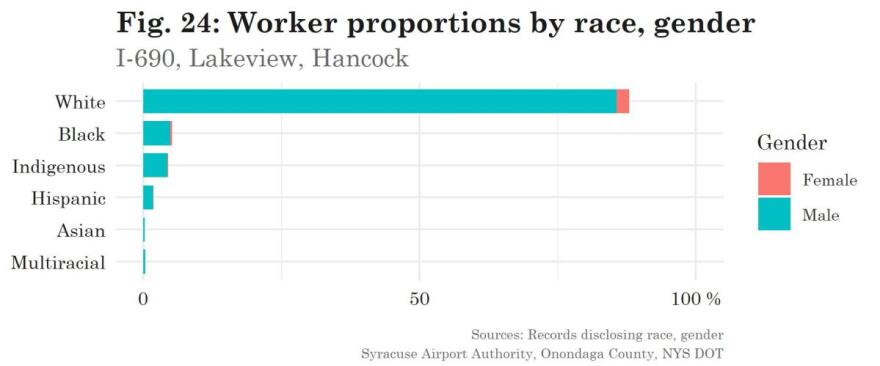Some of the biggest public construction projects in Central New York are doing the least to help Syracuse’s minority population get jobs and reduce local poverty. An analysis by two local groups found the workforces don’t mirror the racial makeup of the city or the county. WAER’s Chris Bolt reports how public investments in progress could pay more dividends.
Construction projects might seem like the perfect place to promote diversity in the workforce … and get some of Syracuse’s impoverished residents good-paying jobs. Many projects have public money in them – either paid for by tax dollars like roads and sewers, or beneficiaries of government grants or tax breaks. But Andrew Croom … who worked on the report to chronicle just who’s working … found results that surpassed any notions or assumptions he had.
“Workforces are white in Central New York and we’ve seen it driving by them. Was I ready for how white they were? No. You know, living in a city that’s 50% minority and 50% white, I expected a project like I-690 that’s two blocks from my house to be represented by the city where it is. And it was so far from that, that yes, I found those results shocking.”
So they wanted to see if minorities were getting at some equitable amount of the work. The Urban Jobs Task Force and Legal Services of Central New York analyzed Hancock Airport Renovations, the I-690 project, the Lakeview Amphitheater and others. They found 88-percent of workers were white … black and indigenous around four-percent, with a few Hispanic and Asian workers. In a city with 49-percnet minorities and a county that’s more than 25 percent minority.

Urban Jobs President Deka Dancil says there are historical reasons why minorities don’t have – and aren’t ready for – a lot of the jobs.
“Because of the economic and racial segregation that was caused by I-81, urban renewal, and redlining, that made the networks of minorities only be with other poor minorities. And the networks of white people, for people who had the paying jobs, who might’ve been exposed to the construction trade. I tell you that my whole time growing up in high school, I never even heard a thing about it.”
She notes other barriers get in the way, such as non-paid training, and lack of transportation or child care, that prevent many in poverty from getting into programs that lead to jobs.
There are ways to ensure more minority inclusion on projects that get public money … project labor agreements, minority hiring goals that are part of contracts. Croom, with Legal Services, says they could go further.
"What we found though is that there are a lot of projects throughout the United States that have dealt with this issue. LA Metro in Los Angeles creating community workforce agreements within their PLAs. Having the unions in the community work together to say ‘we want this in the PLA’s to make sure there’s local hiring.' I think what it comes down to that there has to be a big table, there has to be collective action, to say ‘we’re all here. We all want the same thing.’ So, we have to work together to make those policies."
He could see more collaboration with Unions … and have them more actively recruit in the city, plus more targeted training. These ideas are getting attention. Mayor Ben Walsh recently launched Syracuse Build to help train people in the city, so more are ready for the many workers that might help with the I-81 project. Dancil is looking for more leadership.
“Our mayor, before he received this information, realized that this was important, so I just really hope that himself and the county executive, and the DOT, and our state representatives, that they put their money where their mouth is, and they make sure that our city is trying and are prepared and they have access to those jobs well before they come down the pipeline.”
The report by the two groups – Building Equity in the Construction Trades – comes up with recommendations to: help with the barriers for training by subsidizing child care and transportation; create more pathways to higher skills, through better education and apprenticeships; and forge hiring agreements among all relevant parties.
https://issuu.com/lscny/docs/reisfinal_3-8-19_compressed
During interviews for their study, Croom found willing partners
“Everybody seems to see the need and the desire to do it. That was probably one of the most uplifting things about the report was that when we sat down with the developer, they did not scoff at the idea to do this. They said, ‘this has to happen. This is our city.’ And they see the need to do it and they acknowledge that and they’re ready and I think willing to do it. I just think that it just takes that group of people to make that happen.”
Dancil is not so optimistic, having seen years of meetings on this same topic. She’d like to see the voices of local residents join with policy makers and industry.
“People can call up our local elected officials and tell them and our state officials to please do everything they can to use their political power, allocate some resources and personnel to make sure that our city’s workforce is trained because they need access to these jobs to revive our city’s economy. The contracts that are going to come from this is going to be great. The redevelopment of that land is going to be great, but the local jobs that are going to come as part of the problem are just as essential to the city’s revitalization.”
The entire report, including a petition to support minority inclusion in projects such as I-81 … and other ways to get involved … can be found at the Urban Jobs Task Force website at UJTF.org
https://issuu.com/lscny/docs/reisfinal_3-8-19_compressed



